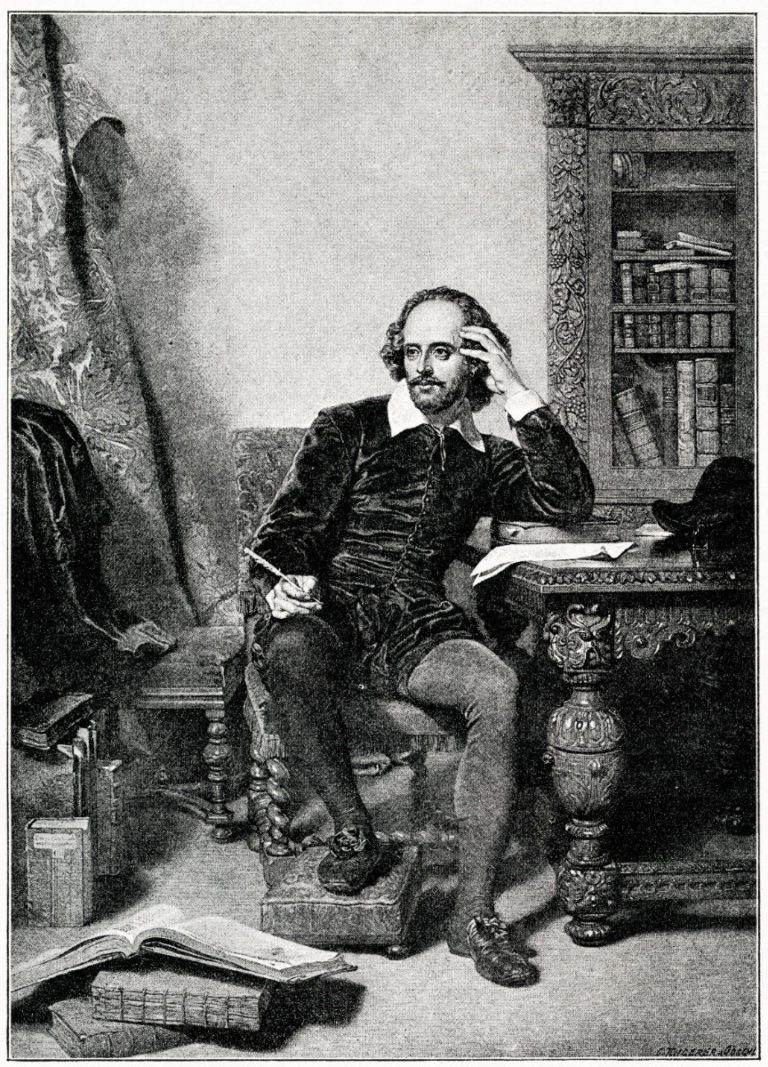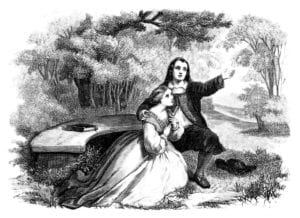Background
The age of Shakespeare is among the most turbulent periods in English history. His parents’ generation had grown up in the shadow of the Reformation, an event that brutally rejected what most people had previously believed to be gospel-true. Rome would now no longer be all-powerful; Latin would no longer be the language of worship; monasteries, closed down and in many cases physically dismantled, would no longer serve as a kind of prototype welfare state.
A generation later, England’s isolation from Catholic Europe was vividly illustrated by the threat of war with Spain. In the event, a combination of naval supremacy and meteorological good luck defeated the Spanish Armada, briefly liberating Shakespeare’s London from the threat of invasion. But by now there were concerns about the Succession, with an all-powerful monarch both ageing and childless – set against the background of recurring visitations of the plague, that regularly culled quite fearsome fractions of the population.
Much of the historical background finds its way into the forty-odd plays that come down to us, somewhat luckily, from Shakespeare’s life and times. Living in historical times provoked an appetite for history among London’s citizens that Shakespeare was able to satisfy with his accounts of the Hundred Years War with France and the Wars of the Roses; and anxieties about power – how it is used and abused, how it is won and lost – emerge as familiar ingredients of his plays.
A Stratford Childhood
The paradox at the centre of Shakespeare’s life must be that although he is among the most celebrated figures in human history, we know very little about him. Still, some details are clear. He was born in Stratford in April 1564 to parents whose own parents had been farmers nearby. His father John had married the landlord’s daughter, then left the land to work as a glove-maker (there are over fifty references to gloves in Shakespeare’s work) and later a civic administrator, serving as Mayor in 1568. Initially highly successful, he seems to have fallen on hard times later in life, being accused of recusancy – or being a closet Roman Catholic – at a time when this charge was worth avoiding. He died in 1601, when his son was in his late thirties.
Shakespeare was the eldest of five surviving children. Three sons – Gilbert, Richard and Edmund – and a sister, Joan, reached adulthood, though the three boys all pre-deceased him; Edmund, who followed him to London and into a career in the theatre, died in 1607. The young William was educated at Stratford Grammar School, where he was trained in a curriculum that relied heavily on some of the Classical texts which later in life formed the basis for his dramas: at least seven of his plays are set in Classical Greece or Rome. He might have expected to proceed from there to university, but if his father did indeed fall on hard times in the early 1580s (for which there is some evidence), then family finances may have proved problematic.
Few dates in Shakespeare’s life can be depended on at this distance, but in 1582, he married Anne Hathaway, daughter of a local farmer, eight years his senior. The wedding took place in something of a hurry; six months later, his oldest child Susanna was born. Three years later, in 1585, when Shakespeare was 21, he became a father a second (and third) time, when twins Hamnet and Judith were born. Hamnet died in 1596, and Shakespeare’s work thereafter is laced with problematic relationships between fathers and daughters. Fathers and sons are less prominent.
Lost Years
Shakespeare found fame in London but he kept up a close connection with Stratford, returning home every year (it seems), investing in property, maintaining his family and eventually, aged nearly fifty, returning home to retire. Nevertheless between the mid-1580s and the early 1590s, there is no record of his whereabouts. There is a story of him working as a schoolmaster in the north west of England, though it is possible (if less likely) that these so-called “lost years” are when he gained his working knowledge of Italian towns like Padua and Mantua, Venice and Verona, which feature in his plays. But there is no evidence either way.
He next appears in the written records in the mid-1590s, paid for appearing in a play performed by the Lord Chamberlain’s Men in London. So if he nursed an ambition as a young man in provincial Stratford to seek a place for himself in the London theatre, he has begun to gain a foothold there – as an actor. But there is also evidence around this time of plays being performed in London which are now firmly associated with his name – “Henry VI part 2” and “Henry VI part 3”, together with “Titus Andronicus” – so by the early 1590s it seems clear that his “Lost Years” are behind him and his direction is set.
These years were plague years in London, complete with lockdowns. Among the casualties were the theatres, regarded as efficient spreaders of a disease so ruthless it took out as many as ten per cent of the population and so severe it could kill within days of infection. If Shakespeare was earning his corn as an actor and writer for the London stage, as seems likely, then he had now to seek alternative sources of income. He turned his hand to writing poetry, and in 1593 – 4, composed two poems, “Venus and Adonis” and “The Rape of Lucrece”, which established his reputation as the best-known, most widely-read poet in England, especially admired at the universities. Four hundred years after his death, it is hard to think of Shakespeare first finding fame as a poet rather than as a dramatist, but that is what happened.
“An Upstart Crow”
Shakespeare brought out no poetry of great substance from 1594 until 1609, when his 154 sonnets were collected and published. But it seems most likely these poems – even perhaps, the relationships they explore – were part of his private life during the 1590s. Otherwise it seems he was preoccupied with writing drama, at this stage around two plays per year. These were written not for publication but for performance, and in this respect he was lucky in that the theatre troupe he joined – The Lord Chamberlain’s Men – was stable in its personnel and well respected, increasingly in demand for performances at Court.
The Queen and her guests would have been entertained by two quite distinct genres when Master Shakespeare’s company were invited. With the Spanish Armada only recently defeated, these were historical times, and history was proving a popular genre for audiences keen to reflect, initially, on the Wars of the Roses (“Henry VI part 1”, ”Henry VI part 2”, “Henry VI part 3” and “Richard III”, probably written between 1590 and 1592) or on the Hundred Years War with France (“Henry IV part 1”, “Henry IV part 2” and “Henry V”, 1597 – 8). Other histories like “Richard II” (1595) and “King John” (1596) reinforce the theme.
At the same time, Shakespeare’s reputation as a great dramatist of comedy and romance was being forged in these productive years, which saw the appearance of “The Comedy of Errors” (1589), “The Taming of the Shrew” (1593), “The Two Gentlemen of Verona” (1594), “A Midsummer Night’s Dream” (1595), “Love’s Labour’s Lost” (1594) and “Much Ado About Nothing” (1598). Other romances with a harder edge emerged too, including “Romeo and Juliet” (1594) and “The Merchant of Venice” (1596).
“This Wooden O”
If Shakespeare was lucky in his theatre company, they were lucky in him, since his fluent pen provided them with a steady stream of new material to put on the stage for the wide range of theatre-goers his drama seems to have attracted. His plays were not published as texts in the way they would be now, since they were written to be performed, not published, and publication might well reduce the take at the gate. Rather, the protocol dictated that the playwright complete his text and then sell it to the company, who would then own it outright.
Shakespeare became a shareholder in the Lord Chamberlain’s Men probably around the mid-1590s. Initially they performed at the Curtain Theatre north of the river, but legal conflicts with the freeholders, who owned the land on which the theatre stood, inspired desperate measures, and late in 1598 a dozen associates of the company dismantled the theatre and carried it across the river Thames to Southwark, where it was rebuilt and dubbed The Globe Theatre – a reminder if one were needed that “All the world’s a stage, / And all the men and women merely players”.
By this stage in his career, Shakespeare and his company were sufficiently well-regarded to attract invitations to put on private performances. One such invitation was met in February 1601, when the Earl of Essex requested and paid for a private performance of “Richard II”, in which a weak monarch is forced to resign, and is then murdered. On the following day, Essex launched an attempted coup against Elizabeth, with ranks of privately-recruited volunteers charging on horseback through the streets of London in increasingly confused circles. Shakespeare and his companions were forced to argue their innocence of any association with the planning for the insurrection. The Earl of Essex, formerly a favourite of the Queen, was executed three weeks later.
The King’s Men
The Queen died in 1603, to be succeeded – painlessly, as it turned out, much against expectations – by James VI of Scotland, who became James I south of the border. James reached London with the reputation for favouring the artistic type of courtier over the swashbuckling adventurers who had caught the late Queen’s eye, and Shakespeare, nearing forty and at the height of his powers, knew enough about ambition to make it one of his most prominent themes.
This was the period in Shakespeare’s career that saw the emergence of his most formidable work. Beside the four great tragedies “Hamlet” (1600), “Othello” (1604), “King Lear” (1606) and “Macbeth” (1606) came plays as powerful and distinctive as “Antony and Cleopatra” (1606), “Coriolanus” (1607) and “Timon of Athens” (1607). In these and other plays, Shakespeare explores human instincts and emotions – jealousy, loyalty, honesty, love – against a wider background of power and authority beneath the eye of a universe that is often (as “King Lear” demonstrates most powerfully) cruel and unforgiving.
In the last phase of his writing, the conflicts that punctuate these great texts are often put to one side or resolved in late plays which, like “The Winter’s Tale” or “The Tempest”, find reconciliation in repentance and redemption – as if, in his later years, the author was able to cast a forgiving eye over humankind, away from the nihilism of his great tragedies. His writing comes to a close with something of an anti-climax, in that “Henry VIII” (1612) is an exercise in scrupulously avoiding controversy while “The Two Noble Kinsmen” (1613), which he co-wrote with John Fletcher, is a shadow of his earlier comedies and romances.
Post script
With the success of “Venus and Adonis” and “The Rape of Lucrece”, the poems he published in the early 1590s, Shakespeare was most likely a wealthy man from around the age of thirty. He invested most of this wealth in Stratford, buying not only property but also land – he was, after all, descended from farmers. He was also able to acquire for the first time a property in London, in the Blackfriars, though it is notable that when he was called to give evidence in a court case in 1612, he described himself as being “of Stratford upon Avon”. He also invested in a coat of arms for his father.
His daughters both married: the older Susanna to John Hall, a respectable Stratford doctor. They had a daughter, Elizabeth, the last of Shakespeare’s direct descendants, who died in 1670. His younger daughter Judith married the unsuitable Thomas Quiney, who was less than an asset, but who fathered three sons, all of whom their mother outlived. The house the playwright bought in Stratford with the money he made in London was occupied by descendants of his sister Joan until 1806, having been commemorated as his birthplace in 1769.
He died in 1616, and was buried in Stratford church, his grave notable for the monument put up in his honour some seven years later. That statuette and the famous if clumsy Martin Droeshout engraving are the only evidence we have of his appearance – nothing remains that was drawn, painted, sculpted or carved in his lifetime. His plays were collected in 1623 as the First Folio by theatrical companions John Heminges and Henry Condell, without whose labours we would not now have around half his plays. Six signatures remain and a smattering of other documents that pricelessly record this elusive life, but it remains something of an irony that this most polished wordsmith who gave so much of himself to pen and paper should have left behind – in one sense – so little for the scrutiny of later ages.




